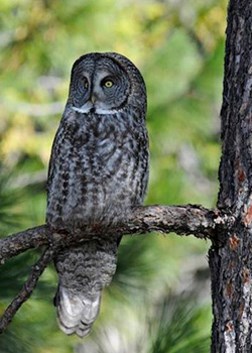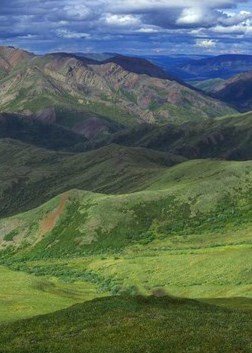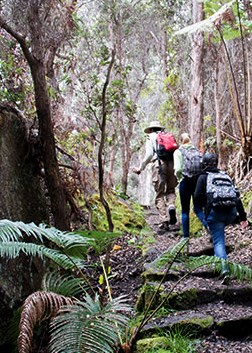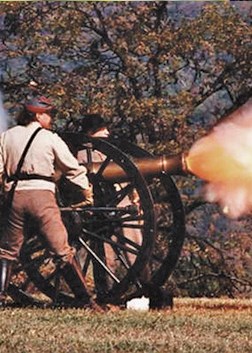
© Joe Medley
Wildlife
Animals depend on hearing natural sounds in the environment for a range of activities, including:
• Communication
• Establishing territories
• Finding habitat
• Courting and mating
• Raising families
• Finding food and avoiding predators
• Protecting the young
Sounds convey important information about the ecosystems animals inhabit. Wildlife behavior is linked to these places. In its natural environment, a fox can hear sounds of rodents even under snow! The fox depends on its ability to hear these sounds for its next meal, and other sounds that might alert it to danger.
Many animals are heard before they are seen. Take amphibians, for example. While most are almost impossible to spot, their calls travel for miles. The surround sound effect of trilling spring peepers makes it difficult for predators to isolate one frog from another. The greater the chorus, the greater the protection! Wetlands are critical habitat for amphibians. What else do sounds reveal about their ecosystems?
Did you know?
• When returning to the colony with food, a sea lion mother finds her pup by recognizing its voice.
• Rattlesnakes shake their tails to alert intruders to their presence, saving them the trouble of an attack.
• Killdeer use a distinct, high-pitched trill, while faking a broken limb, to distract predators from their nests.
• Many bird songs can be described in human phrases. For example, the American Goldfinch call sounds like the words "potato chip!" and Chickadees helpfully call out the sound of their own name, "chicka-dee-dee-dee!"
• Male cicadas produce the loudest sounds in the insect world. Entomologists believe that the sound protects these insects by hurting predators' ears.
Loud sounds in the park landscape disrupt these and other animal functions. Learn about the effects of noise on wildlife.

NPS
Wilderness
On September 3, 1964, President Lyndon B. Johnson signed into law the Wilderness Act. This historic bill established the National Wilderness Preservation System and designated an initial 9.1 million acres of wilderness for the enjoyment and benefit of the American people.
Over 80 percent of all National Park Service lands are managed as wilderness—including deserts, alpine meadows, tundra, lava beds, swamps, rocky crags, and coasts. The NPS protects the overall wilderness character of these places. The natural sounds present in wilderness are part of an interconnecting system of resources that wildlife depends on for survival, and visitors seek when journeying to these quiet places.
“Wilderness sounds would be here, bird songs in the morning and at dusk. The aspen leaves would whisper and the pines as well, and in the sound of water and wind I would hear all that is worth listening for.” Sigurd Olsen
Noise in wilderness creates a domino chain of effects. Learn about the effects of noise on wilderness.
Check out this creative NPS interactive wilderness website about NPS wilderness programs and places in general.

NPS
Visitors
Natural sounds are vital to your experiences in parks. They sharpen your senses and connect you to the park environment. Have you ever heard the reverberating thud of male bighorn sheep butting heads, roar of a waterfall, or slap of a beaver's tail on the water's surface? Visitors who have experienced these and other natural sounds in parks often describe them as powerful memories they will cherish for a lifetime. Even sounds more commonly heard such as bird songs, wind through grasses and trees, frog croaks, and chirping insects are a captivating part of the park experience.
The variety of natural sounds in parks contributes to the richness of its soundscape. Scientific research finds that hearing these sounds brings health benefits for humans, too, such as lowered stress, improved mood, cognition and social well-being. Noise can affect your park visit. Surveys show that the American public comes to parks for opportunities to experience natural quiet and the sounds of nature. The NPS works to provide this experience for our park visitors.

NPS
Cultural-Historic
The specific sounds associated with our history or cultural heritage not only teach us about the past, they connect us to distant times and places in a way that few other things can. The whistle of a train, clang of mission bells, Native American drumming, and crack of musket fire are sounds that carry meaning about the American experience. Many of these cultural sounds represent significant moments in the country's development. They connect us to historical aspects of a park and reinforce our nation's heritage.
In this way, cultural sounds symbolize a time and place in history. For example, the clacking of fabric looms in the textile factories at Lowell National Historical Park convey automation and the rise of the machine at a time when workers were leaving the farm for the city. The resonant ring of an iron spike driven into a rail at Golden Spike National Historic Site depicts a nation linked for the first time by the railroad. The screech of sirens at Oklahoma City National Memorial reminds us of tragedy and loss of life. And the sounds of gunshots and human cries contrasted with the silence of an empty prairie during a re-enactment at Bear Paw Battlefield are haunting reminders of the anguish of the Nez Perce Indians as they ceased their struggle against the white man.
Additionally, many important moments in U.S. history are defined by a musical style. Music uplifts us through time and space and recreates a mood. An interpretive tour of the Vietnam War Memorial is enhanced with a recording of conflict songs from the 1960s. Native American music sets a jubilant or reverent atmosphere, and the lighthearted sounds of ragtime piano recall the spirit of the gold rush days.
What sounds are meaningful to you? Enjoy a range of sounds recorded in parks and featured on our Sound Gallery page. Check also our calendar of sound-related events hosted by national parks.
Learn how noise can be disruptive to the cultural-historic experience.
Last updated: February 16, 2018
